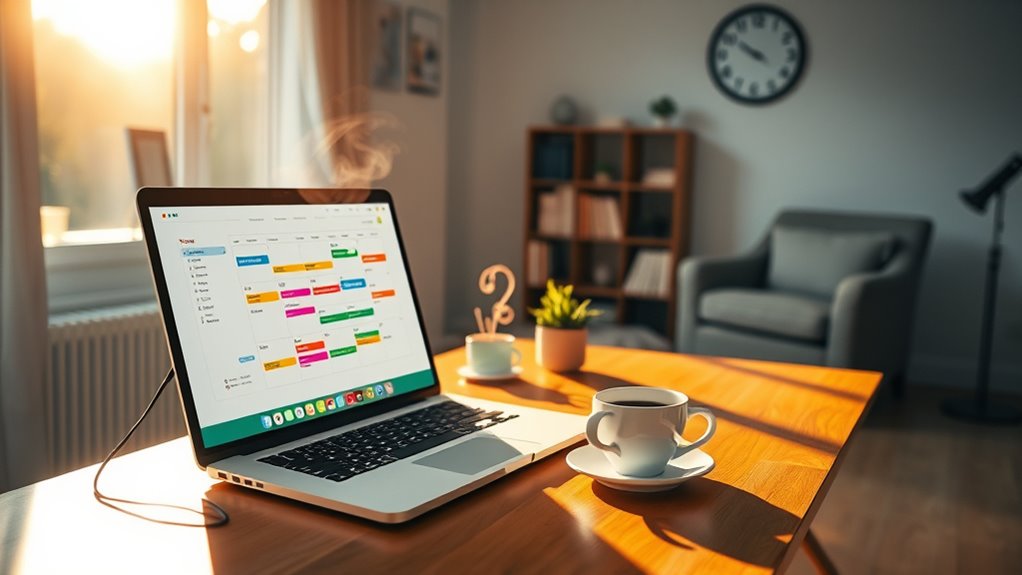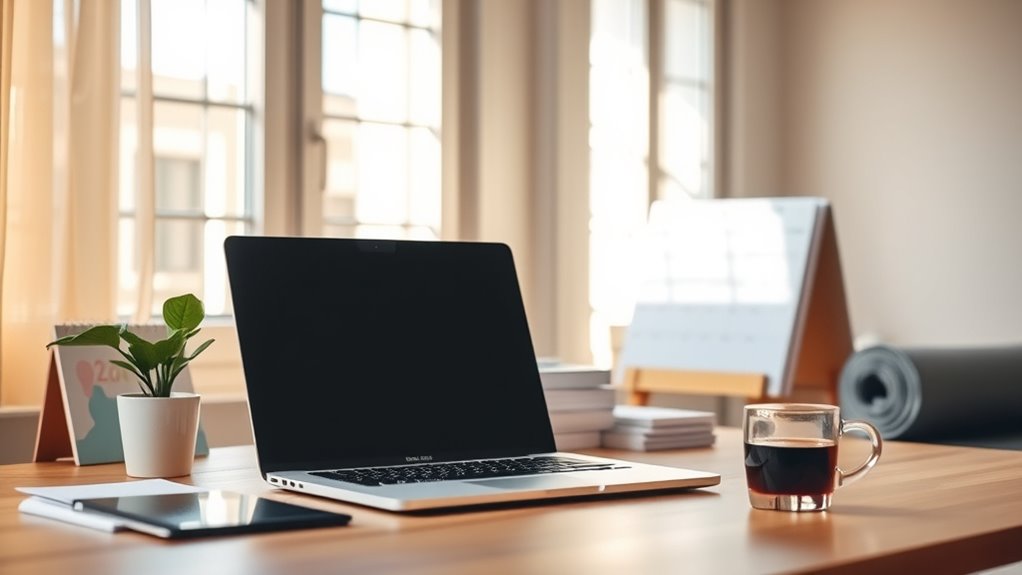Achieving work–life balance is essential for your overall well-being, boosting productivity, and preventing burnout. You can start by setting clear boundaries, like designated work hours and personal time, and communicating them effectively. Prioritize tasks to focus on what’s important and schedule breaks for self-care. Building a supportive environment and managing stress through mindfulness helps maintain this harmony. Keep flexible and open to adjustments; exploring these strategies further will help you create lasting balance.
Key Takeaways
- Establish clear boundaries by setting designated work and personal time to prevent overlap and promote balance.
- Prioritize tasks using effective time management strategies to focus on important activities and reduce stress.
- Foster open communication and support networks at work and home to enhance understanding and boundary-setting.
- Incorporate regular self-care practices and mindfulness techniques to manage stress and maintain well-being.
- Continuously reassess and adjust goals and routines to adapt to changing circumstances and sustain work–life harmony.
Understanding the Importance of Balance

Why does maintaining a work–life balance matter? It’s essential for your overall workplace wellness and personal happiness. When you find the right balance, you can manage stress better, stay motivated, and avoid burnout. Work–life integration allows you to blend professional and personal responsibilities smoothly, making it easier to stay engaged in both areas. Prioritizing balance helps you set boundaries, ensuring work doesn’t take over your life and you still have time for family, hobbies, and self-care. This not only boosts your productivity but also enhances your mental and physical health. Recognizing the importance of work–life balance encourages a healthier, more sustainable approach to your daily routine, leading to improved job satisfaction and well-being. Additionally, understanding the role of home environment in your overall well-being can contribute significantly to achieving this balance.
Recognizing the Signs of Imbalance

You might notice you’re feeling constantly tired or physically drained, even after rest. Emotional signs like irritability, frustration, or feeling overwhelmed can also signal an imbalance. Recognizing these warning signs early helps you take steps to restore your work–life harmony. Being aware of work–life balance concepts and strategies can further support your efforts to regain equilibrium.
Physical Fatigue Indicators
Physical fatigue is often the first sign that your work and personal life are out of balance. You might notice muscle soreness after simple tasks or feel a lingering post work fatigue that doesn’t go away with rest. These signs indicate your body is overtaxed, signaling you to slow down and reassess your routines. Persistent muscle soreness, especially if it worsens or lasts several days, suggests you’re pushing too hard physically. Similarly, feeling exhausted after work, even when you’re not physically active, shows your energy reserves are depleted. Ignoring these signs can lead to more serious health issues. Pay attention to these physical indicators, and consider adjusting your workload or incorporating more rest to restore balance. Recognizing symptoms of physical fatigue early can help prevent it from developing into more serious health problems.
Emotional Burnout Signs
Emotional burnout often signals that your work and personal life are out of sync. You might notice subtle signs that indicate your emotional resilience is weakening. Recognizing these signs is essential for burnout recovery. Here are three key indicators:
- Feeling overwhelmed or irritable even after a good night’s sleep.
- Losing interest in activities that once brought joy.
- Experiencing persistent feelings of cynicism or detachment from work and relationships.
These emotional cues show you’re emotionally drained and need to prioritize self-care. Ignoring them can deepen the imbalance. By acknowledging these signs early, you can take steps toward restoring your emotional resilience and achieving healthier work–life harmony. Remember, burnout recovery begins with awareness and proactive self-support. Self-care practices are vital for maintaining mental clarity and overall well-being.
Setting Clear Boundaries Between Work and Personal Life

Establishing clear boundaries between work and personal life is essential for maintaining balance and preventing burnout. When you set defined start and end times, you create space for personal activities and rest. This promotes work life integration without sacrificing your well-being. Consider the following strategies:
| Boundary Type | Practical Examples |
|---|---|
| Work hours | Set specific hours for work tasks |
| Personal time | Reserve evenings for family or hobbies |
Using flexible schedules can help you adapt boundaries to your needs. Communicating your limits clearly with colleagues and loved ones to ensure respect is also crucial. Additionally, understanding relationship dynamics can help you navigate boundary-setting more effectively in personal and professional contexts. By defining these boundaries, you protect your personal time and enhance productivity during work hours. Ultimately, intentional boundary-setting helps you achieve a healthier work–life balance.
Prioritizing Tasks Effectively

To balance your work and personal life, you need to manage your tasks wisely. Using effective time management strategies helps you stay organized and focused. By setting clear priorities, you guarantee that your most important tasks get done first, reducing stress and increasing productivity. Incorporating techniques like task prioritization can further streamline your daily routines and improve overall well-being.
Time Management Strategies
Effective time management begins with learning how to prioritize tasks based on their importance and urgency. Once you identify your priorities, you can implement strategies to stay on track. For example, you might:
- Schedule mindful breaks to recharge, ensuring you maintain focus and clarity.
- Set clear, achievable goals daily to keep yourself motivated and organized.
- Use a task list to categorize activities by priority, tackling urgent and important tasks first.
- Incorporate regular breaks and self-care techniques, such as relaxation techniques, to reduce stress and enhance productivity.
Setting Clear Priorities
How do you guarantee you’re focusing on what truly matters? It starts with setting clear priorities. Practice workplace mindfulness to stay present and recognize which tasks align with your goals. An ergonomic workspace helps you work efficiently, reducing distractions and physical strain. Break down your to-do list into urgent and important tasks, then tackle high-priority items first. Use tools like calendars or task managers to organize your day. Regularly reassess your priorities to stay aligned with your evolving goals. Remember, not everything needs immediate attention—learning to say no is key. By consciously prioritizing, you direct your energy toward meaningful work and personal balance, ensuring that your efforts lead to both productivity and fulfillment. Incorporating effective time management strategies can further enhance your ability to maintain a healthy work–life balance.
Managing Time to Maximize Productivity

Managing your time wisely is essential for maximizing productivity and maintaining a healthy work–life balance. Effective time management supports work life integration and helps you stay focused. Start with these steps:
- Prioritize your tasks based on importance and deadlines, ensuring critical items are completed first.
- Use time block planning to allocate specific periods for work, breaks, and personal activities, reducing distractions.
- Set boundaries to protect your designated work times, preventing work from spilling into personal life.
- Incorporate research-backed insights to continuously refine your time management strategies and stay aligned with your goals.
The Role of Technology in Maintaining Balance

Technology can be a powerful ally in maintaining work–life balance when you use digital organization tools to stay on top of tasks. It also makes remote collaboration easier, so you can work flexibly without sacrificing productivity. However, managing notifications effectively helps you avoid constant interruptions and stay focused on what matters most. Incorporating nutrient-rich ingredients in your diet can further support your energy levels and overall well-being.
Digital Organization Tools
Digital organization tools have become essential in helping you maintain work–life balance by streamlining your tasks and schedules. They enable efficient app organization, so you can access everything quickly and avoid chaos. To stay balanced, consider these steps:
- Use task management apps to set priorities and deadlines, reducing overwhelm.
- Schedule regular digital detox periods to disconnect from screens and recharge mentally.
- Organize your apps into folders or categories, making it easier to find tools and minimize distractions.
Remote Collaboration Ease
Streamlining your apps and organizing your digital workspace helps you stay efficient, but effective remote collaboration takes it a step further by enabling seamless communication and teamwork from anywhere. Technology fosters virtual team building, making it easier to connect regardless of physical distances. Tools like video conferencing, shared documents, and instant messaging support real-time collaboration, promoting clarity and engagement. Cross-cultural communication becomes smoother when you leverage translation features and culturally sensitive platforms. To highlight this, consider the following:
| Benefit | Key Feature |
|---|---|
| Improved team cohesion | Virtual team building activities |
| Enhanced understanding | Translation and interpretation |
| Increased productivity | Real-time document sharing |
| Stronger relationships | Regular informal check-ins |
| Greater inclusivity | Culturally aware communication |
Embracing these tech strategies simplifies remote teamwork, balancing work and life more effectively.
Managing Notifications Effectively
Managing notifications effectively is essential for maintaining work–life balance, especially when constant alerts can easily disrupt focus and increase stress. Your notification habits shape your daily flow, so customizing alerts helps you regain control. To do this, consider:
- Setting specific times to check notifications, avoiding constant interruptions.
- Using alert customization features to prioritize important messages and mute non-urgent ones.
- Turning off non-essential notifications during focused work or personal time to reduce distractions.
Creating a Supportive Environment at Work and Home

Creating a supportive environment at work and home starts with clear communication and setting boundaries. At work, seek out workplace mentorship to build trust and guidance, which encourages openness and mutual respect. This support helps you feel valued and understood, reducing stress. At home, prioritize family communication by sharing your needs and listening actively. When everyone understands each other’s boundaries and expectations, it fosters a harmonious atmosphere. Be proactive about discussing challenges and celebrating successes together. This balance of open dialogue and defined limits creates a foundation of support, making both environments more nurturing. By cultivating transparency and respect in both settings, you develop a strong network that sustains your well-being and work-life harmony.
Incorporating Self-Care Into Daily Routines

Incorporating self-care into your daily routines is essential for maintaining balance and overall well-being. To do this effectively, consider these steps:
Prioritize daily self-care routines to support your balance and overall well-being.
- Start your day with a few minutes of mindful meditation to center yourself before tackling tasks.
- Pack nutritious snacks like nuts, fruit, or yogurt to fuel your body and keep energy levels steady.
- Take short breaks during work to stretch or breathe deeply, helping clear your mind and reduce tension.
Strategies for Handling Stress and Burnout

When stress and burnout start to take over, taking proactive steps can make a significant difference in restoring balance. One effective strategy is practicing mindfulness, such as deep breathing, meditation, or grounding techniques, which helps you stay present and reduce anxiety. Incorporate regular mindfulness practices into your daily routine to build resilience against stress. Additionally, seek social support—talk with friends, family, or colleagues who can offer encouragement and perspective. Sharing your feelings can lighten your emotional load and foster connection. Remember, acknowledging stress and addressing it early prevents burnout from worsening. By combining mindfulness practices with a strong support network, you empower yourself to manage stress more effectively, maintaining your well-being and work–life harmony.
Maintaining Flexibility for Long-Term Well-Being

Maintaining flexibility in your routines and expectations is essential for long-term well-being. Flexibility strategies help you adapt to changing circumstances and build long-term resilience. To stay flexible, consider these approaches:
Flexibility in routines and expectations is key to resilience and sustained well-being.
- Adjust your goals regularly to reflect new priorities or challenges.
- Keep open communication with colleagues and loved ones to manage expectations.
- Allow room for spontaneity and breaks, preventing burnout and maintaining motivation.
Frequently Asked Questions
How Can Employers Promote Better Work–Life Balance for Employees?
You can promote better work–life balance by offering employee flexibility, allowing staff to adjust their schedules or work remotely. Implement wellness programs that support mental and physical health, showing you value their well-being. Encourage open communication and set clear boundaries around work hours. By fostering a supportive environment, you help employees manage stress, increase satisfaction, and ultimately boost productivity and loyalty.
What Are the Long-Term Health Effects of Poor Work–Life Balance?
Ignoring the long-term health effects of poor work–life balance can lead you to face burnout risks and chronic stress. Over time, these issues may cause serious health problems like heart disease, anxiety, and depression. You might also experience decreased immunity and sleep disturbances. To protect your well-being, it’s vital to set boundaries, prioritize self-care, and manage workload effectively, reducing the risk of long-term health consequences.
How Does Work–Life Balance Vary Across Different Industries?
Did you know that industry-specific burnout varies widely? In sectors like healthcare and finance, workers often clock sector work hours exceeding 50 per week, leading to higher stress levels. You’ll find that work–life balance shifts depending on your industry, with some fields demanding more hours and sacrificing personal time. This imbalance can cause long-term health issues and decreased job satisfaction, so understanding sector demands helps you manage your well-being effectively.
Can Remote Work Improve Overall Work–Life Balance?
Remote work can improve your overall work–life balance by offering flexibility benefits, allowing you to tailor your schedule around personal needs. This flexibility helps reduce stress and commute time, giving you more control over your day. However, be aware of tech challenges like connectivity issues or distractions at home. By managing these, you can enjoy the advantages of remote work, leading to a healthier, more balanced life.
What Role Does Organizational Culture Play in Achieving Balance?
Organizational culture shapes how you manage your balance by emphasizing values alignment and leadership influence. When your company’s values prioritize well-being, and leaders model healthy boundaries, you’re more likely to feel supported in balancing work and personal life. A positive culture encourages open communication and flexibility, empowering you to set boundaries without guilt. Ultimately, a strong, value-driven culture fosters an environment where achieving balance becomes a shared goal.
Conclusion
Remember, balance isn’t a one-time achievement but a daily practice. You need to recognize your limits, set your boundaries, prioritize your well-being, and adjust your routines. Embrace self-care, manage stress, and stay flexible to adapt to life’s changes. Keep aiming for harmony in work and personal life. Because when you nurture yourself, support your goals, and stay mindful, you create a life that’s fulfilling, sustainable, and truly balanced.









